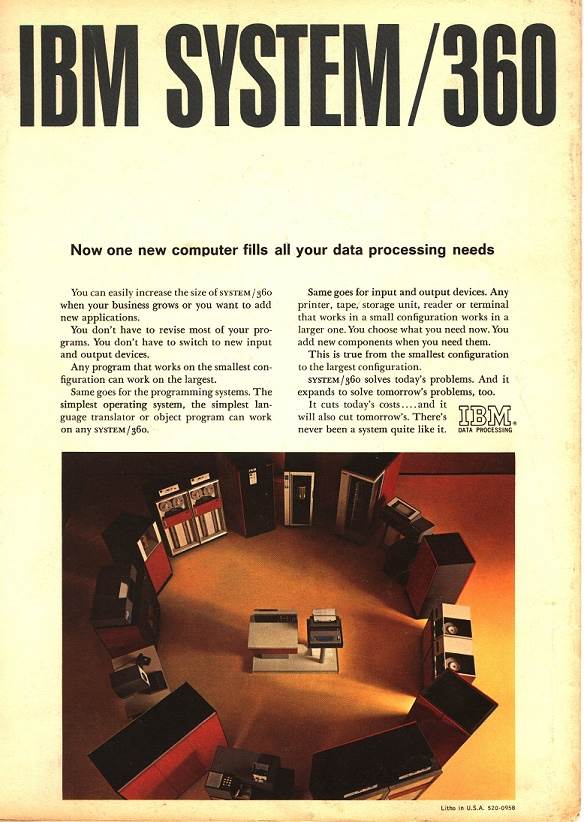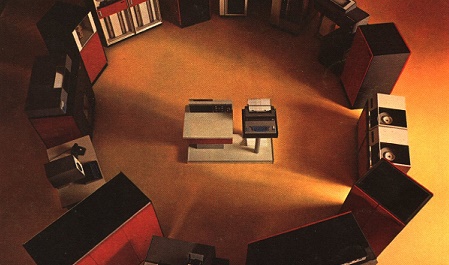Preamble
The Australian Computer Society (ACS) was formed 50 years ago, when the various state computer societies joined forces.
To mark the occasion, the ACS has initiated a heritage project to honour the many individuals who have contributed to the growth of the ICT profession in Australia.
At the heart of the project is a history of computing in Australia. It is not just a history of the ACS, but the history of a profession.
Australia has the longest computing history of any country, excepting the US and the UK, and CSIRAC in the Museum of Victoria is the oldest computer still in existence.
Chapter 14: IBM redefines the computer industry
In 1964 IBM released the System/360 – the computer that defined the modern computer industry.
IBM was once the world's largest computer company by far. The early history of commercial computing is, to a large extent, the history of IBM and its competitors’ responses to its dominance.
International Business Machines, as it was known, is a direct descendant of the company founded by Herman Hollerith to make tabulating machines for the 1890 US census. Hollerith merged with two other companies in 1911 to form the Computer-Tabulating-Recording Corporation (CTR), which was renamed IBM in 1924.
IBM was shaped by two men, father and son. Thomas J. Watson Sr led the company from before World War l to after World War II, and his son Thomas J. Watson Jr from the 1950s to the 1970s. Watson Sr is famous for his remark that he estimated the total world market for computers at only six or seven machines.
Fortunately for IBM, he was soon convinced otherwise, and IBM released its first electronic computer, the Model 701, in 1953. IBM soon overtook its early rivals, such as Sperry Rand, and by the early 1960s was selling twice as many computers as all its rivals combined – in Australia as well as globally.
The modern mainframe era began when IBM announced the System 360 range in April 1964. Australia was to get some of the first machines. The S/360 forever changed the way people thought about computers. It was the first ever family of computers, the first example of a consistent architecture across computers of a different size.
That meant that the different machines could use the same peripherals and software, making it easy to move to a larger computer within the range, and to move on to new models as they were released. (The ‘360’ was meant to indicate the degrees of the compass).

We are family
The idea of a family of computers seems quite normal now, but back in the early 1960s it was revolutionary. Previous IBM machines, such as the 1401, were incompatible with other machines in IBM's range. Every time IBM, or anybody else, brought out a new computer, users had to rewrite their entire applications suite and replace most of their peripherals.
In the early 1960s IBM was under threat from many competitors, particularly Control Data and Honeywell. The lack of a consistent architecture did nothing to engender customer loyalty. IBM conceived the S/360 as a way of protecting its market share.
The S/360 was the biggest gamble in IBM's history, before or since. The company invested more than US$6 billion (a figure exceeding IBM's annual revenues at the time). IBM thought it would get its money back in a couple of years, but the success of the machine greatly exceeded the company’s expectations. It sold twice as many as it had hoped, and the architecture became the de facto standard for mainframe computing.
The S/360 excelled nowhere, except as a concept, but it could fit just about everywhere. For the first time, upward compatibility was possible. The phrase ‘upgrade path’ entered the language.
Then came the lawsuits
But it also locked the users into IBM, which of course was IBM's aim. The S/360's enormous success, and the sharp commercial strategies that IBM used to achieve that success, were to become the basis for the US Justice Department's long-running suit against the company.
The suit, filed in January 1969, claimed that IBM was violating the USA's anti-trust laws with its S/360 marketing tactics. These relied to a large extent on sowing Fear, Uncertainty and Doubt (three words that have now entered the computer industry's lexicon, often acronymised as "FUD") in the minds of users and potential users of competitors' equipment.
The suit was one of many anti-trust suits filed against IBM in the late 1960s. They all had the same theme, that IBM was monopolising the computer industry. The central idea underlying these suits was that IBM's size, structure, experience, and salesmanship made competition difficult, and were therefore unfair and in violation of the law.
One important suit was filed by Control Data Corporation (CDC), which also made mainframe computers. Its December 1968 suit alleged that IBM had announced a scientific version of the S/360 (the Model 90) with the sole aim of affecting sales of CDC’s Model 6600.
The 360/90 had outstanding specifications, but was not actually shipped for three years after its announcement, during which time CDC claimed its sales suffered – it was unable to sell a single 6600 in the 18 months after the 360/90 was announced.
Hoping to pre-empt the Justice Department’s suit, IBM made the decision in December 1968 to ‘unbundle’ software from hardware – to sell software separately, rather than include it as part of the total system.
Software separates from hardware
In the early days of computing hardware was the expensive part – software, most of which had to be written from scratch – was comparatively inexpensive. As software became more sophisticated, with introduction of operating systems and programming languages, this remained the case. In 1969, there was virtually no applications software market – everybody wrote their own applications.
IBM’s decision to unbundle software from hardware was to have important consequences. It essentially meant the start of the software industry. For the first time, people could write software for IBM computers and compete against IBM.
Most major software companies of the 1970s and 1980s began in this manner, and they showed the way for many others who followed. There was an immediate explosion in the availability of applications and systems software from independent software vendors.
In 1969, the total global revenues of software products companies was variously estimated at something between US$20 million and US$50 million. It grew to $400 million by 1975. Services companies like Computer Sciences Corporation (CSC), TRW and Westinghouse entered the software market. The few existing vendors, like ADR and Informatics, experienced a boom.
New suppliers like MSA and Cullinane built financial applications, a small company from Cincinnati called Cincom released TOTAL, an early database management system. In 1971, Germany’s Software AG entered the market with ADABAS (A DAtaBAse System). All were to be early entrants, in the 1970s, to Australia’s growing computer industry.
The Justice Department case was thrown out by the pro-IBM Reagan administration in 1982, by which time it had generated over 100,000 pages of evidence. Whatever the merits of the case, the arguments had become academic, and the industry was very different to what it had been like in the late 1960s.
Next week: The S/360 in Australia
Previously published:
Chapter 13: Control Data Australia (part II)
Chapter 12: Control Data Australia (part I)
Chapter 11: The Australian Computer Society
Chapter 10: Five Computer Societies
Chapter 9: Australian made, Australian designed
Chapter 8: Australia's Computer Industry in 1962
Chapter 5: SILLIAC and the Snowy Mountains Scheme
Chapter 3: Harry Messel and the birth of SILLIAC
Chapter 2: The first Australian Computer Conference
Chapter 1 -The start of Australia’s computing history
Veteran ICT journalist Graeme Philipson is researching and writing the Heritage Project book, which is due for release on the 50th anniversary of the formal incorporation of the ACS, on 3 October 2017.
The project also involves the creation of a ‘virtual museum’, cataloguing hardware and other artefacts, and collecting and curating documents on the history of the industry, including oral histories of as many people as possible.
Please get in touch with Graeme if you would like to contribute, at [email protected]
Do you have early memories of the ICT industry in Australia? Help us make history by sending us your story! Record or write your memories to be included in our historic ACS Heritage Project. Details here.










